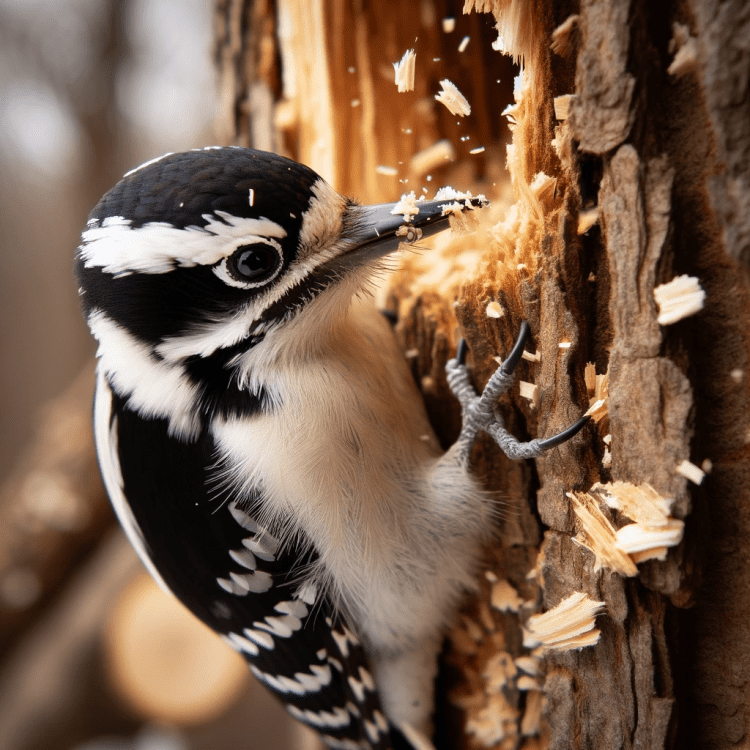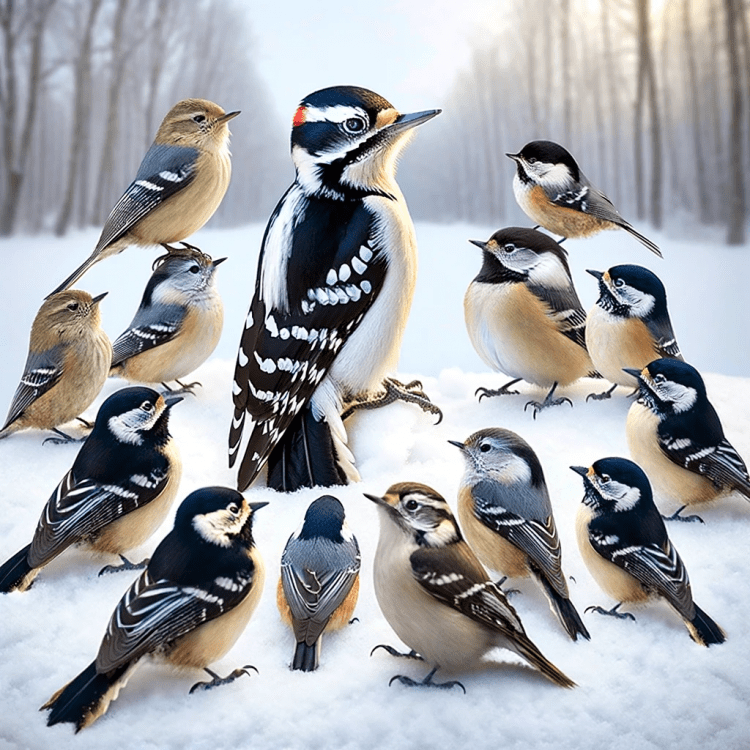
Identifying Downy Woodpeckers in Their Natural Habitat: A Birdwatcher’s Guide
Introduction
Identifying birds in their natural setting is a rewarding aspect of bird watching. The Downy Woodpecker, with its distinctive features and behaviors, offers a fascinating subject for identification. This guide aims to equip bird enthusiasts with tips and insights for recognizing these small yet striking woodpeckers in the wild.
Key Identification Features
- Size and Proportions: Downy Woodpeckers are the smallest North American woodpeckers. Noting their small size and short bill relative to their body is crucial in distinguishing them from similar species, like the Hairy Woodpecker.
- Coloration and Markings: These birds exhibit a black and white color pattern. Key features include a white back with black wings that have white spots, a white underbelly, and a distinctive black-and-white striped head. Males have a small red patch on the back of the head.
- Behavior: Downy Woodpeckers are active foragers. They are often seen moving up and down tree trunks and branches, tapping and probing for insects. Their agility and ability to hang upside down on branches can also aid in identification.
Habitat Preferences
Downy Woodpeckers are adaptable and can be found in various habitats, including deciduous forests, orchards, parks, and suburban areas. Observing these habitats, especially areas with deadwood or dying trees, can increase your chances of spotting them.
Listening for Their Sounds
Vocalizations and drumming are significant in identifying Downy Woodpeckers. Listen for their distinctive “pik” call and the unique pattern of their drumming – a rapid series of taps followed by a pause.
Seasonal Variations
Be aware of seasonal behaviors. During spring and summer, males are more vocal and visible as they establish territories and attract mates. In winter, they may join mixed-species flocks, making them easier to spot in groups.
Using Binoculars and Field Guides
A good pair of binoculars and a field guide are invaluable tools for bird watching. The guide can provide additional information and illustrations to help distinguish Downy Woodpeckers from similar species.
Downy Woodpeckers: A Joy to Watch
Identifying Downy Woodpeckers in the wild can be a delightful and educational experience. These birds, with their distinctive drumming and playful antics, are a joy to watch and an integral part of North America’s avian community.

Delving into the World of Downy Woodpeckers: Nature’s Skillful Carpenters
Introduction
The Downy Woodpecker (Picoides pubescens) is the smallest woodpecker in North America and a familiar sight to many bird enthusiasts. These petite yet industrious birds are known for their distinctive drumming, acrobatic feeding habits, and adaptability to various habitats. This blog post aims to explore the fascinating world of Downy Woodpeckers, shedding light on their unique characteristics and behaviors.
Physical Characteristics
Downy Woodpeckers are easily recognized by their striking black and white plumage. They measure about 5.5 to 7 inches in length, with a wingspan of around 10 to 12 inches. Males have a distinguishing red patch on the back of their head, which females lack. Their size and color patterns often lead to confusion with the larger Hairy Woodpecker, but Downies can be distinguished by their smaller size and shorter bills.
Habitat and Distribution
These birds are widely distributed across North America, from Alaska and Canada down to Florida and Texas. They are highly adaptable and can thrive in a variety of environments, including deciduous forests, orchards, city parks, and suburban areas. Downy Woodpeckers are resident birds, meaning they do not migrate and are present in their range throughout the year.
Diet and Foraging Behavior
The Downy Woodpecker’s diet is quite varied, consisting of insects, seeds, and berries. Insects, particularly beetle larvae hidden under tree bark, make up a significant portion of their diet. They are also known to visit bird feeders, especially in winter, feeding on suet and black oil sunflower seeds.
Their foraging behavior is a remarkable sight. Downy Woodpeckers are skilled at scaling tree trunks and branches, using their strong bills to chisel away bark and extract insects. They also forage on weed stalks and in clusters of dead leaves, showcasing their versatile feeding tactics.

Nesting Habits and Reproduction
Downy Woodpeckers have interesting nesting habits. They are primary cavity nesters, meaning they excavate their own nesting holes in dead wood or diseased trees. Both males and females participate in the excavation, which can take about 1 to 3 weeks. The choice of nesting site is crucial, as it provides protection from predators and harsh weather.
The female lays 3 to 5 white eggs, and both parents share incubation duties for about 12 days. Once hatched, the chicks are altricial (born blind and featherless) and depend entirely on their parents for food and warmth. The nestlings fledge approximately 20 to 25 days after hatching but stay with their parents for several weeks, learning vital survival skills.
Social Behavior
Downy Woodpeckers are somewhat solitary but can be seen in pairs or small family groups, especially during the breeding season. They are known to join mixed-species flocks in the non-breeding season, which provides increased foraging efficiency and predator detection. Their interactions with other species, particularly during winter foraging, are of significant interest to ornithologists.
Vocalizations and Drumming
Vocal communication and drumming are prominent aspects of their behavior. Their call is a sharp “pik” sound, and they also have a variety of softer calls for communication between mates and offspring. Drumming, a rapid tapping on a resonant object, is used for territory establishment, attracting mates, and communication. This behavior is not only fascinating to watch but also an important identifier for birdwatchers.
Conservation Status
Currently, Downy Woodpeckers are listed as “Least Concern” on the IUCN Red List, indicating a stable population. However, they are affected by habitat loss and degradation. Preservation of wooded areas and responsible environmental practices are essential for their continued well-being.
Understanding Downy Woodpeckers
Downy Woodpeckers are a delightful presence in many North American landscapes. Their charming characteristics and behaviors make them a favorite among birdwatchers and nature lovers. By understanding more about these birds, we can better appreciate their role in our ecosystems and the importance of preserving their natural habitats.




